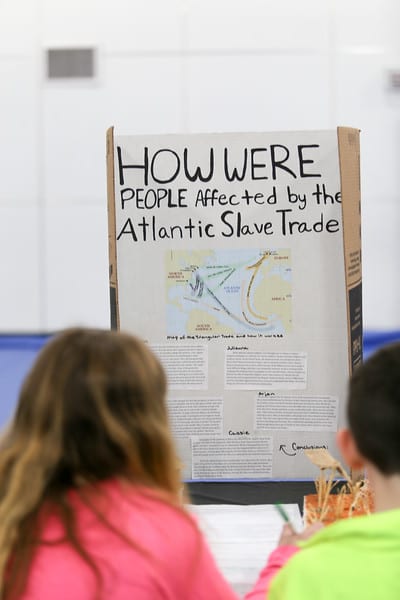The seventh grade history classes immersed themselves for eight weeks in an in-depth study of the Atlantic Slave Trade. The unit culminated in an expansive one-day museum exhibition on March 20 where the middle schoolers could display their Seventh Grade Atlantic Slave Trade Museum. Consisting of over a dozen 3D models and nine documentary style films, the museum allowed students the opportunity to welcome their peers in grades 5-12, faculty, and staff to share in their knowledge.
In their Seventh Grade Atlantic Slave Trade Museum, the middle schoolers documented their learning of this complex period of history. A few examples of the questions and topics explored were:
- The debate on whether racism preceded slavery or vice versa
- Why the institution of slavery was an accepted norm
- The reaction of African societies during the slave trade
- The residual impact of slavery in Africa
- How American culture shifted after the end of slavery
- The daily experience of slaves
- The power wielded by African slave traders
- The tools used during the trade
- The criteria that slave traders sought
For each exhibit, the students also included descriptions and images about their group’s development during their project. For Middle/Upper School History Teacher Jake Greenberg, this dual emphasis on the academics as well as the team dynamics was of great importance.
“The process is more important than the outcome,” said Mr. Greenberg. “Throughout the eight weeks, the students kept logs of prompts where I asked them questions for them to reflect on what they were learning and how they were learning.”
After all projects were completed, Mr. Greenberg invited the seventh graders to ponder a few final questions on their learning experience.
- What surprised you and why?
- What are the most important things you learned?
- How did this experience feel and how did your feelings shift?
- How will you act differently as a result of this experience?
- How will you use this learning in the future?
- What do you want to try now?
The responses to these concluding reflections were shared on poster boards at the Seventh Grade Atlantic Slave Trade Museum. A few humorous responses from the middle schoolers (“I’m surprised we finished.”) were sprinkled in together with applicable lessons that extend beyond just the history classroom (“Prototyping and getting feedback takes more time but will make your finished product better.”).
Visitors to the Seventh Grade Atlantic Slave Trade Museum also had an opportunity to leave feedback for the middle schoolers. Overwhelmingly, the consensus was that the exhibitions were well researched, informative, and impressive.
Click here to view photos from the museum.
To view a sample of three documentary films made by the seventh graders, click the links below.
Did Racism or Slavery Come First?

